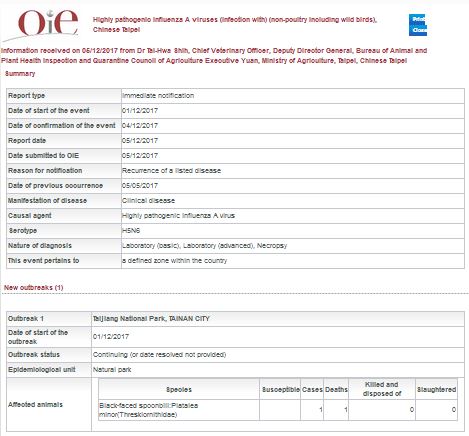#12,949
Yesterday, in Taiwan Reports HPAI H5N6 In Migratory Bird, we saw the third report in as many weeks of an east Asian country reporting the fall return of H5N6.
In November both South Korea and Japan unexpectedly reported the arrival of an entirely new reassorted H5N6 virus comprised of the HA and internal genes from last year's European H5N8 virus and the NA from a European H3N6.
Last week, in Tottori University: Shimane HPAI H5N6 A New Reassortment, we were presented with a description, and the following chart.
Today, via an OIE notification, we learn that yesterday's announced find of H5N6 in Taiwan - nearly 1,000 miles south of the earlier South Korea and Japan detections - is also a new reassortment of HPAI H5N8.
Some excerpts from that report, then I'll return with a bit more.
Source of the outbreak(s) or origin of infection
Unknown or inconclusive
Epidemiological comments
On 1 December 2017, one dead black-faced spoonbill was found in Taijiang National Park (Republic of China) by the staff of the National Park and was sent to the National Laboratory (Animal Health Research Institute, AHRI) by the local Livestock Disease Control Center (LDCC). H5N6 subtype of highly pathogenic avian influenza was detected and confirmed by the AHRI in the evening of 4 December 2017.
The LDCC disinfected the neighboring areas of the spot where the dead black-faced spoonbill was found and has completed clinical examination and sampling of all poultry farms (four chicken farms) within 5 km radius of the spot. All chicken in the four farms are clinically healthy. They are under intensified surveillance for three months to detect, if any, spreading of the virus. In addition, to be further well-prepared for the increased risk of HPAI epidemics, the government have launched active surveillance over three categories of higher risk poultry farms: (1) poultry farms located within 3 km radius around wetlands nationwide; (2) outdoor feeding duck farms; and (3) native chicken farms.
The irony here is that over the summer the fear was the Asian H5N6 would make its way to Europe, or to North America, much the way that H5N8 had over the past couple of years (see Germany: FLI Risk Assessment On Return Of HPAI H5 Avian Flu).According to preliminary analysis by the AHRI, the current H5N6 virus is different (identity 92.4%) from the H5N6 virus that was detected in February 2017, but is closely related to the one found in wild birds in Japan last November. The HA genomic sequences share about 99% identity with the H5N8 virus which has caused major outbreaks in Europe from late 2016 to early 2017. The NA genome is similar to the HxN6 which is widespread in wild birds in Eurasia.
While that could still happen, for now we are dealing with a spin off from last year's H5N8 European epizootic, one that is showing remarkable persistence and spread along the East Asian Flyway.How it stacks up against its parental H5N8 virus, or the Asian H5N6 it seems to have (at least temporarily) usurped, remains to be seen. So far, we aren't seeing the number of outbreaks we were seeing last year in either Asia or Europe.
The only good news is that with an H5N8 parentage, it may be less able to infect mammals than a descendant from the Asian H5N6 virus. But of course, these viruses continue to evolve and adapt, and so nothing can be stated with certainty.Nevertheless, we appear to have a new biologically `fit', highly mobile HPAI virus to watch. One whose southward spread appears to be even faster than was H5N6's last year.
Stay tuned.


